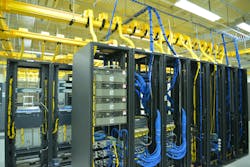How data centers can solve their water consumption challenge
Data centers face a critical challenge in keeping their servers cool. The industry already uses copious amounts of energy, and cooling creates a big water demand too. The rise of artificial intelligence (AI) and high-density computing makes the undertaking even more daunting because both generate significantly more heat than traditional workloads.
According to the International Energy Agency (IEA), a typical 100 megawatt (MW) hyperscale data center in the United States consumes around 2,000,000 liters of water per day, equivalent to the use of 6,500 homes. As data centers continue to pop up around the world, and with water as a finite resource, owners and operators are looking for ways to be more efficient and sustainable.
Various cooling methods exist, but water-based cooling is by far the most popular. Research shows that water and other liquids can be 50 to 1,000 times more efficient at transferring heat than air cooling systems. This high efficiency is why most hyperscalers and large colocation providers continue to rely on liquid cooling, even amid growing water conservation concerns.
However, it is important to note that many advanced liquid cooling systems, unlike continuous-use cooling towers or adiabatic systems, are filled a single time and then require very little additional fluid under proper operation. For example, a system with a 10,000-gallon capacity might need less than 500 to 1,000 gallons annually for maintenance. Despite this, Bloomberg News reports that two-thirds of new data centers built in the U.S. since 2022 are in areas already facing water stress.
During summer months, this consumption often increases as cooling systems work harder to maintain optimal temperatures against rising heat.
Regulatory pressures are also mounting in the European Union, which adopted reporting requirements for data center water usage last year. Some tech companies aim to improve their sustainability without that force: Last year, Microsoft announced designs for data centers that do not use water for cooling at all. That direction, while ambitious, may not be the most popular path forward.
Alternative water sources
Forward-thinking data center operators are exploring alternative water sources to reduce their dependency on municipal supplies. These include treated municipal wastewater, which can undergo additional treatment before being used for cooling purposes. Rainwater collection systems installed on-site can capture natural precipitation for use in cooling systems. Surface water from canals, lakes or other natural sources offers another option, as Google has demonstrated at its facility in the Netherlands, where it uses canal water rather than potable water.
Veolia has a vast municipal water network and can work with operators to treat municipal wastewater and supply it to their cooling systems.
By using alternative water sources, data centers reduce pressure on local drinking water supplies, often face easier permitting processes in water-stressed regions, enhance their sustainability credentials and build goodwill with surrounding communities concerned about water resources.
How Veolia helps data centers
Veolia offers end-to-end services for data centers seeking to optimize their water usage. Our approach begins with source identification, finding sustainable water sources based on local availability. We provide equipment for water treatment and reclamation, along with a full set of water chemistry programs to maintain water quality at the optimal level. This comprehensive approach helps improve the efficiency of cooling systems while preserving equipment integrity over time.
For instance, a data center in Illinois sought a new water treatment strategy to reduce its dependency on the municipal water supply. Our experts determined that the existing alkaline cooling system was limiting the cooling tower’s cycles of concentration and caused high blowdown rates that increased demand for make-up water.
Veolia installed a TrueSense Ready-Set-Go (RSG) controller to monitor pH and feed sulfuric acid into the cooling system to simplify management for the data center’s operators and leverage remote monitoring and alarms. The new treatment program doubled the cooling tower cycles and reduced the amount of water needed to operate the system by 50%. The result was 12 million gallons of water saved annually and $150,000 in associated cost savings.
Conclusion
As the AI revolution accelerates and global temperatures continue to rise, investing in water conservation technologies is an environmental and business imperative for data centers.
The industry is moving in exciting new directions. Some operators are exploring immersion cooling, where servers are fully submerged in non-conductive fluids, greatly reducing or eliminating the need for water cooling entirely. Others are pursuing hybrid approaches that combine traditional water cooling with more efficient designs to minimize consumption.
The path forward requires an ecological transformation with water management in mind. Data centers that act now to improve their water efficiency will be better positioned to handle both seasonal heat waves and the long-term challenges of climate change and regulatory requirements.
Note: A version of this article originally appeared on the Veolia blog, which can be found here.
